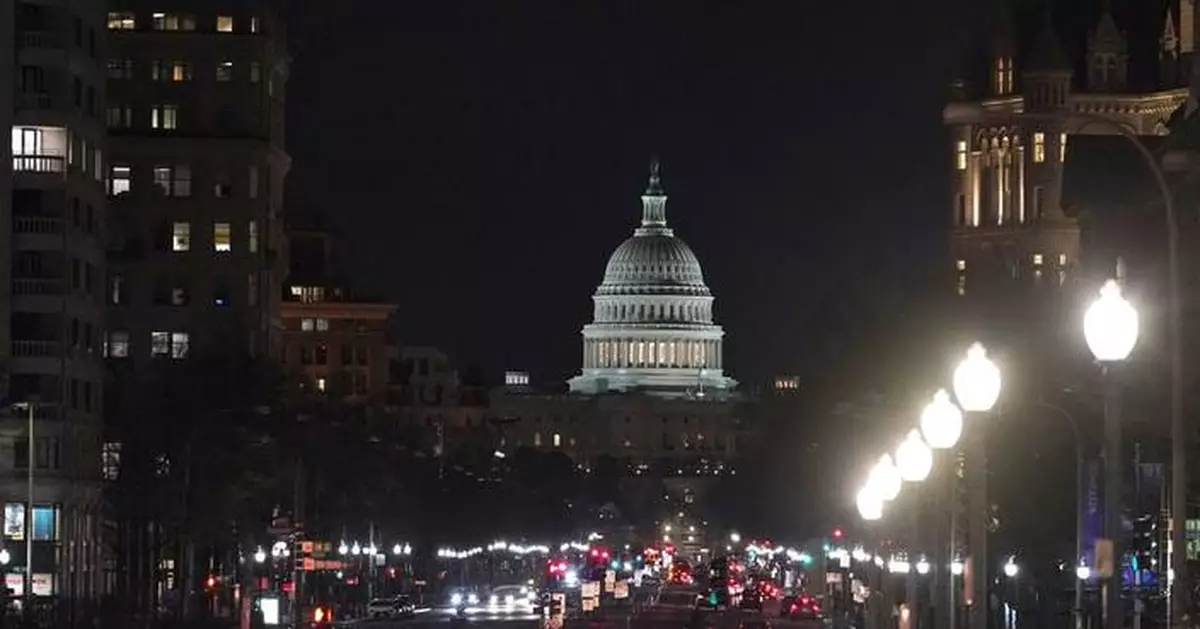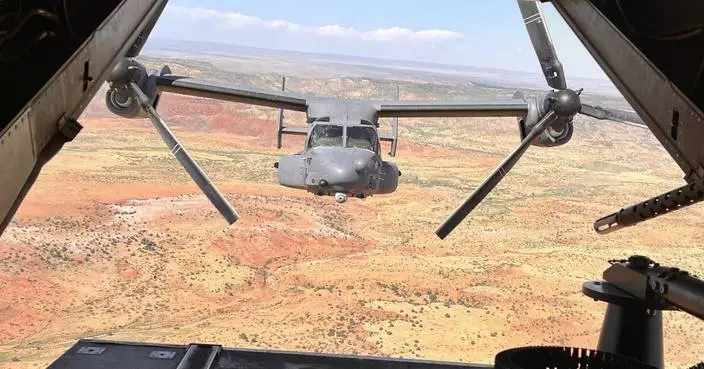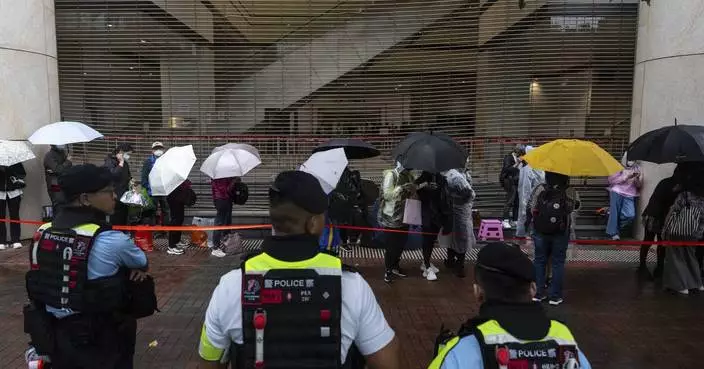WASHINGTON (AP) — Donald Trump's first stint in the White House proved to be a chaotic ride for the District of Columbia.
Now with Trump set to return to power — backed by a Republican-controlled Congress and the momentum of a sweeping electoral win — local officials in the nation's capital are trying to sound conciliatory while preparing for the worst.
“We have been discussing and planning for many months in the case that the District has to defend itself and its values,” said Mayor Muriel Bowser. Her office had “communicated with (Trump's) team and indicated we would like to speak,” she said on Nov. 12, but hadn't heard back.
Bowser downplayed the myriad differences between the two sides and emphasized a search for common ground. But those commonalities may be hard to come by, given open mutual animosity that has defined Trump's relationship with the district.
During Trump’s turbulent first four years in office, he and the local government publicly sparred multiple times — in tones ranging from playful to deeply personal. When Trump floated the idea of a massive July 4 military parade complete with tanks rolling through the streets, the D.C. Council publicly mocked him.
When mass protests broke out in the summer of 2020 over the death of George Floyd and wider police brutality and racial issues, Trump accused Bowser of losing control of her city. he eventually declared his own multi-agency lockdown that included low-flying helicopters buzzing protesters. Bowser responded by having “Black Lives Matter” painted on the street in giant letters one block from the White House.
During the last four years, with Trump as an aggrieved private citizen, his feelings toward Washington have remained intense. On the campaign trail, he repeatedly vowed to “take over” the city and usurp the authority of the local government. In August 2023, when he briefly came to town to plead not guilty on charges of trying to overturn his 2020 electoral loss to President Joe Biden, Trump blasted the capital city on social media, calling it a “filthy and crime ridden embarrassment to our nation.”
Now Bowser and the D.C. Council are bracing for what could be several years of playing defense against opponents who wield significant power over Washington's affairs.
“We just have to do our best and hold on for another few years. We have to figure out how to make it work,” said Councilmember Christina Henderson. “Unlike millions of voters around the country, I actually believe the man when he speaks. He said what he’s going to do.”
Henderson, a former staffer for Senate Majority Leader Chuck Schumer, D-N.Y., points out that Trump has already experienced what she called “the trifecta” — Republican control of the White House and both houses of Congress — during his first two years in office and the district managed to get through it. She also notes that Republican control of the House of Representatives will be up for grabs again in just two more years.
“I can’t predict what they're going to try to do to us," she said. "I can just prepare to respond.”
But responding to the intentions of an antagonistic White House and Congress is difficult, given the nature of the District's limited autonomy. Under terms of the city's Home Rule authority, Congress essentially vets all D.C. laws and can outright overturn them.
Even when Trump was out of the White House, activist Republicans on the House Oversight Committee repeatedly summoned Bowser and members of the D.C. Council — often to publicly grill them about local crime rates.
And by far the most extensive modern congressional encroachment on the District's authority came with Democrats controlling both the Senate and the White House. In 2023, a sweeping rewrite of the D.C. criminal code was branded as soft on crime by House Republicans; in a major setback for the council, both Senate Democrats and President Biden agreed and the law was effectively canceled.
“We know that the district can always be a convenient foil to some of these folks," said Councilmember Charles Allen. "Without statehood, without autonomy, our laws are always more at risk than any other Americans.”
Both councilmembers predict a wave of budget riders on the annual appropriations bill — designed to alter district laws in ways big and small. These riders have been a longtime source of resentment for local lawmakers, who charge Congress members with tinkering with the district in a manner they could never get away with at home.
"They want to do something to the district because they feel they can. They would never do that to their own state,” Allen said.
He highlights the infamous “Harris rider” named for Maryland Rep. Andy Harris. A staunch opponent of legalized marijuana, Harris has for years used a budget rider to prevent the local government from creating any sort of regulatory framework for taxing or controlling sales. Meanwhile, Maryland has since legalized recreational marijuana use.
“He can’t implement it in his home state, but he can do it to us,” Allen said.
Last year's appropriations bill initially included riders that would have banned all traffic speed cameras in the nation's capital and prevented the district government from banning right turns on red lights. Those proposals eventually faded during the negotiation process, but Allen feels that the coming Congress "won't have Democrats in the same position to help negotiate away many of the most objectionable budget riders.”
Other congressional Republicans have sought to make more fundamental changes to the way Washington operates. Rep. Andrew Clyde of Georgia has proposed completely repealing the Home Rule Act, while Rep. Andy Ogles of Tennessee has talked publicly of abolishing the office of D.C. mayor. Neither Ogles' nor Clyde's office responded to Associated Press requests for comment on their future intentions.
Despite the looming battles, Bowser's search for common ground with Trump and congressional Republicans may not be completely hopeless. Bowser actually vetoed the criminal code rewrite but was overridden by the D.C. Council; her opposition was frequently cited by congressional Republicans as proof of how far the council had strayed from mainstream Democratic policy.
And Bowser, Trump and Republicans in Congress have all agreed for years on one particular issue: the need to end post-pandemic teleworking and bring all federal employees back to their offices five days a week. She said she looked forward to discussing that with Trump.

FILE - The U.S. Capitol is viewed looking east from Freedom Plaza Jan. 23, 2022, in Washington. (AP Photo/Mariam Zuhaib, File)
After being grounded for months following a crash last November that killed eight service members in Japan, the V-22 Osprey — a complicated aircraft that flies fast like a plane but converts to land like a helicopter — is back in the air.
But there are still questions as to whether it should be.
Since the military started flying the aircraft three decades ago, 64 personnel have been killed and 93 injured in crashes. Japan’s military briefly grounded its fleet again late last month after an Osprey tilted violently during takeoff and struck the ground.
To assess its safety, The Associated Press reviewed thousands of pages of accident reports and flight data obtained through the Freedom of Information Act, interviewed more than 50 current and former program officials, crew members and experts, and flew both simulator and real training flights.
The AP found that safety issues have increased in the past five years and that the design of the aircraft itself is directly contributing to many of the accidents.
Yet past and present Osprey pilots — even those who have lost friends in accidents or been in crashes themselves — are some of the aircraft’s greatest defenders. Ospreys have been deployed around the world, rescuing U.S. service personnel from ballistic missiles in Iraq and evacuating civilians in Niger.
“There’s no other platform out there that can do what the V-22 can do,” said former Osprey pilot Brian Luce, who has survived two crashes. “When everything is going well, it is amazing. But when it’s not, it’s unforgiving.”
The AP found that the top three most serious types of incidents rose 46% between 2019 and 2023, while overall safety issues jumped 18% in the same period before the fleet was grounded.
Moreover, the AP found that over the past five years, not only have incidents climbed for both the Marine Corps and Air Force, but that the rise in safety problems largely involved the Osprey’s engine or drive system.
There were at least 35 instances where crews experienced an engine fire, power loss or stall, 42 issues involving the proprotors and at least 72 instances of chipping. That means that the gears inside the transmission or drive system become so stressed they flake off metal chips that can quickly endanger a flight.
The Marine Corps maintains that the Osprey is still one of the safest aircraft in its fleet. Over the past decade, the rate that it experienced the worst type of accident resulting in either death or loss of aircraft was 2.27 for every 100,000 hours of flight. That compares with 5.66 for its other heavy lift helicopter, the CH-53.
Those numbers don’t tell the whole story. The Marines’ three most serious categories of accidents climbed from 2019 to 2023 — even as the number of hours they flew their Ospreys dropped significantly, from 50,807 total hours in fiscal 2019 to 37,670 hours in 2023, according to data obtained by the AP.
The Air Force’s Osprey has a much higher rate of the worst type of accidents per 100,000 flight hours than its other major aircraft, and its accidents have also climbed even as flight hours have dropped.
Experts said the Osprey’s failures have a variety of causes. In the 1980s, when the V-22 was still in early concept for Bell Flight and Boeing, the Marine Corps got to call the shots on the Osprey's final design because it committed to buying most of them. The Marines wanted an aircraft that could carry at least 24 troops and take up the same limited amount of space on a ship deck as the CH-46 helicopter, which the Osprey was replacing.
Those design limitations made the Osprey weigh more than twice as much as the CH-46.
Because of the Osprey’s weight, the blades needed to be longer, but couldn’t be — they would have hit the body of the aircraft or the tower on the ship deck.
As a result, the Osprey’s proprotors — which work as propellers while flying like an airplane and as rotor blades when functioning as a helicopter — are too small in diameter for the aircraft’s weight, which tops out at 60,500 pounds.
To help with weight, the Osprey’s entire engine and transmission bends like an elbow to shift to a vertical position when it flies like a helicopter — and engines don’t like to be vertical.
While designing the engines to rotate vertically helped the Osprey takeoff, it also created dangers that crews still have to mitigate today.
When flying as a helicopter, the engines can’t cool down because they don’t get enough air flow. The hydraulic lines at the joint can wear down, and the aircraft is difficult to maintain.
The Osprey’s first fatal crash in 1992 occurred because pooled fluids spilled back down into the engine as the aircraft converted from flying horizontally like a plane to vertically like a helicopter to land. It caught fire and crashed, killing seven.
A 2000 crash that killed four Marines happened when a worn-down hydraulic line ruptured and the Osprey lost power.
Then there’s dust. When the Osprey hovers in helicopter mode, the air and exhaust it creates can kick up a wall of dust and debris that can get sucked back into the engines, clogging and degrading them.
In 2015, a Marine Corps Osprey hovering for 45 seconds in Hawaii disturbed so much sand and dust that the crew had to abort and try again to land, because they could no longer see. On their second attempt, the Osprey’s left engine stalled and the aircraft dropped flat, killing two Marines.
Pilots face very sensitive instruments that change from working like the controls inside an airplane to operating like those inside a helicopter.
The aircraft’s cockpit is also crammed with messaging and navigation screens, and rows of control buttons. The aircraft is frequently flashing error codes — but crews can get desensitized to them, what one Osprey pilot called the “fatigue of small errors.”
If there are other complications in flight or a pilot is distracted or misses the significance of an aircraft warning light, those mistakes can turn dangerous quickly.
Col. Seth Buckley, commander of the 20th Special Operations Squadron, which flies Ospreys, acknowledged that he puts a lot of pressure on his crews to be perfect for their own safety.
“You have to take that mindset because there are so many things you can do in this aircraft to induce worse problems,” Buckley said.
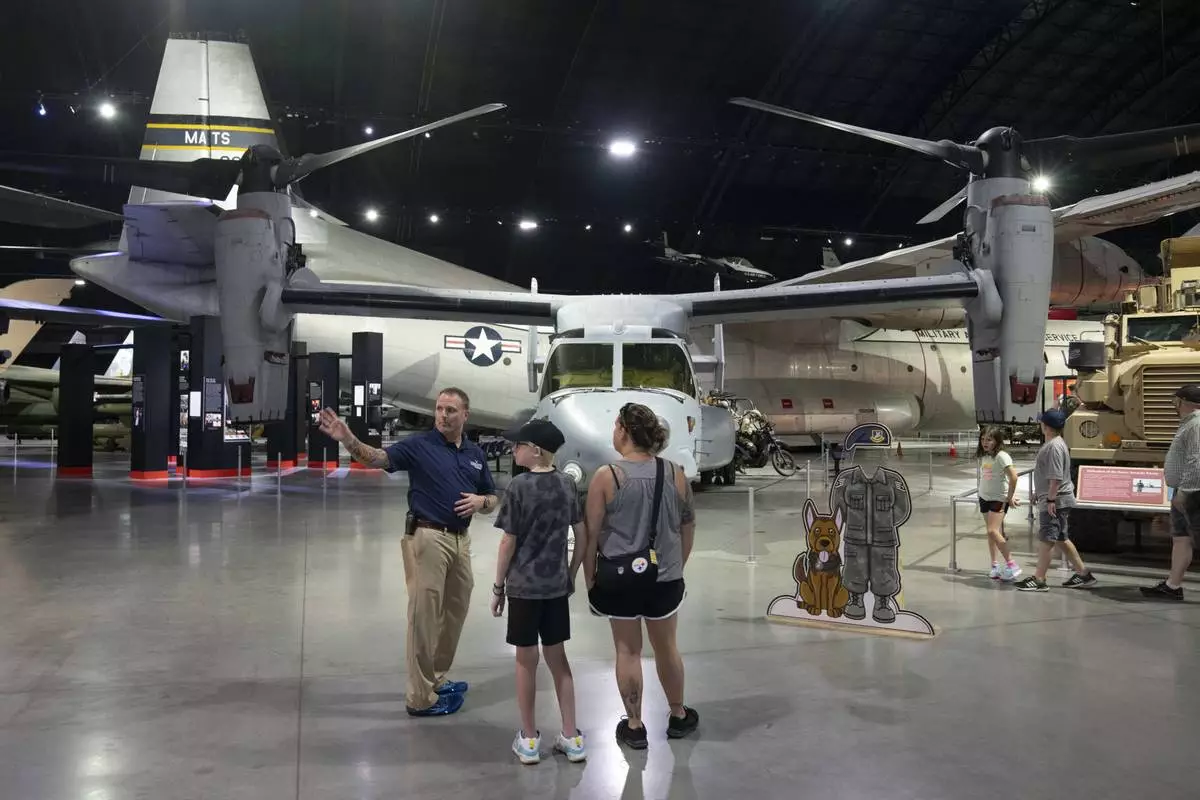
Former Air Force Osprey pilot Brian Luce, left, speaks with museum visitors inside of the Wright Patterson AFB Air Force Museum, Aug. 9, 2024, in Dayton, Ohio. (AP Photo/Jeff Dean)

FILE - Maj. Barry Moore shows a photo of a V-22 Osprey aircraft at a news conference, July 20, 1992, at Quantico Marine Air Station in Quantico, Va., after an experimental V-22 tilt-rotor aircraft crashed into the Potomac River near the air station. (AP Photo/Charles Tasnadi, File)
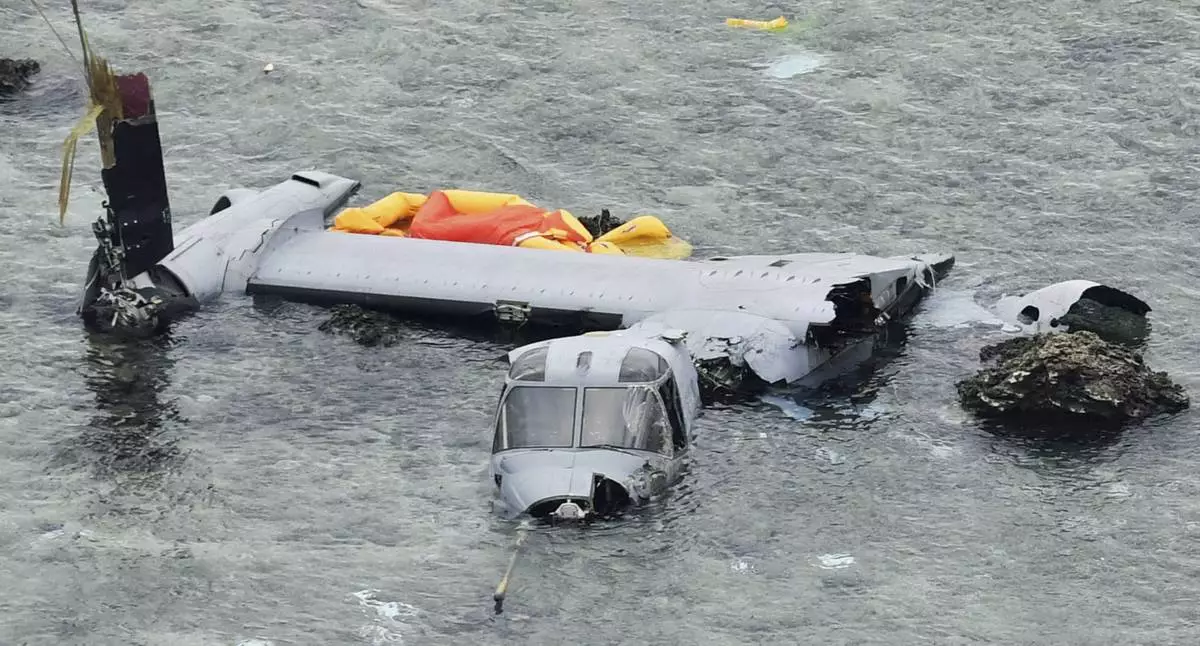
FILE - Wreckage of a U.S. military MV-22 Osprey is seen in shallow waters off Nago, Okinawa, southern Japan, Dec. 14, 2016, after it crash landed. (Yu Nakajima/Kyodo News via AP, File)
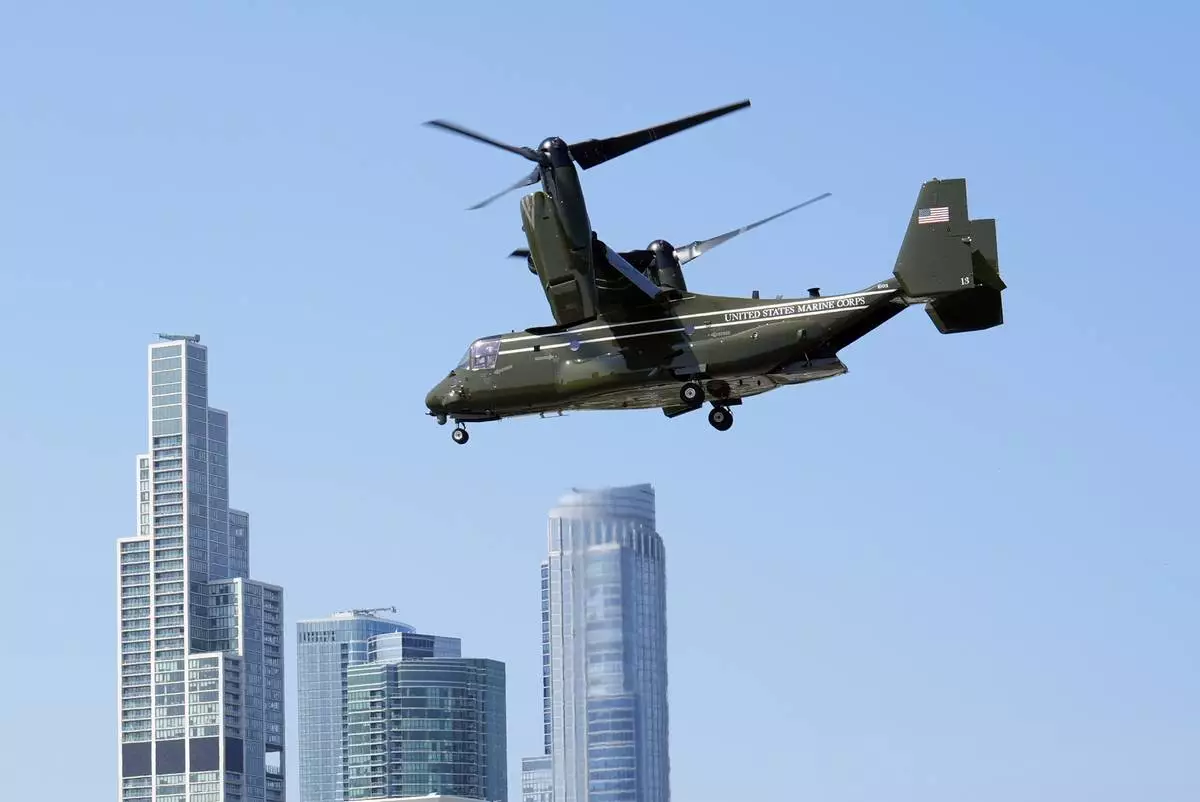
Marine Two, an Osprey tilt-rotor aircraft, with Vice President Kamala Harris and second gentleman Doug Emhoff aboard, lifts from Soldier Field in Chicago, Aug. 23, 2024.(AP Photo/Jacquelyn Martin)
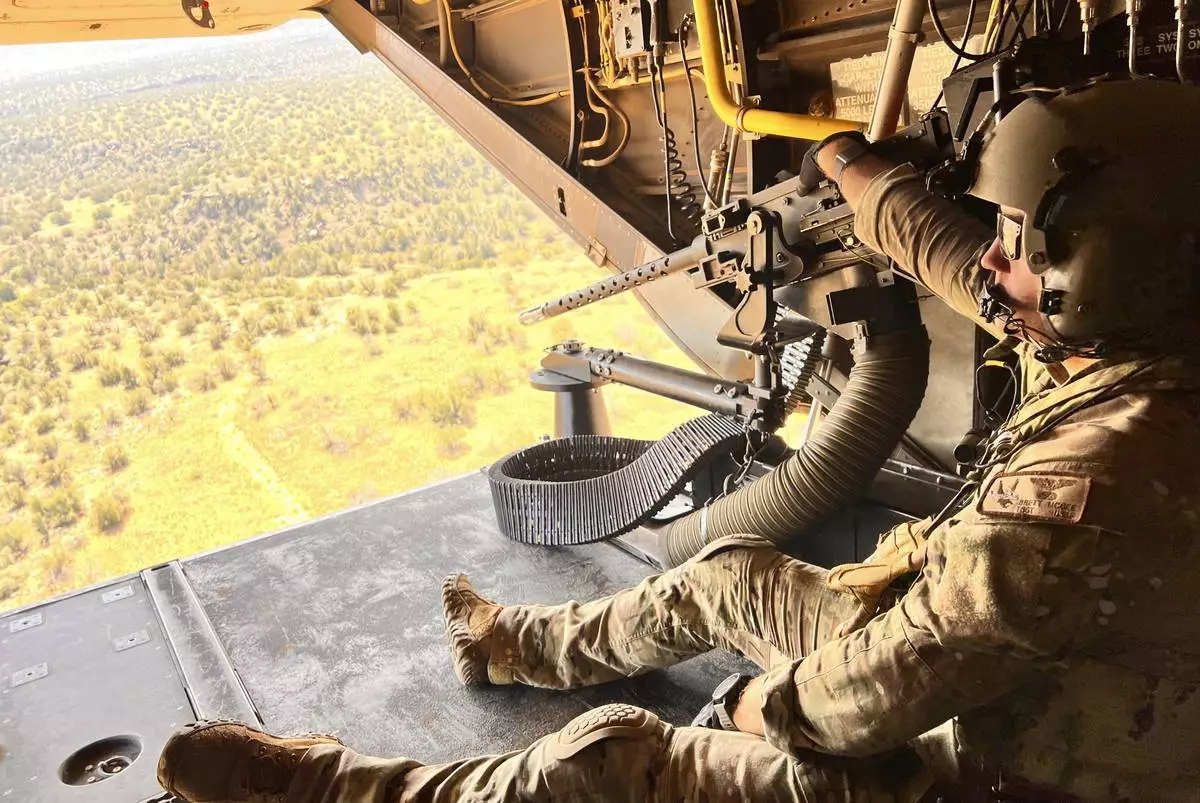
Osprey flight engineer Tech Sgt. Brett McGee sits on the back open ramp of the V-22 and holds the aircraft's .50 caliber gun as the crew flies over a New Mexico training range Oct. 9, 2024, near Cannon Air Force Base. (AP Photo/Tara Copp)

Former Air Force Osprey pilot Brian Luce poses for a portrait inside of the Wright Patterson AFB Air Force Museum, Aug. 9, 2024, in Dayton, Ohio. (AP Photo/Jeff Dean)
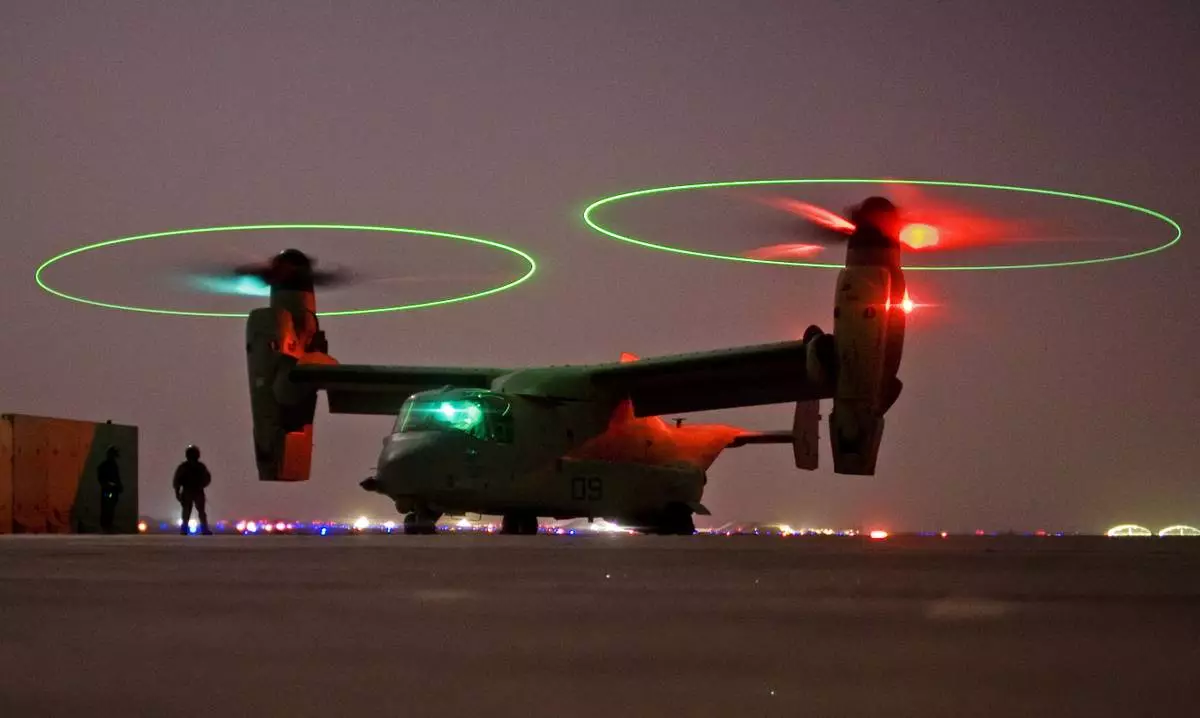
FILE - A V-22 Osprey tilt rotor aircraft taxi's during a mission in western Iraqi desert, Oct. 13, 2008. (AP Photo/Dusan Vranic, File)



